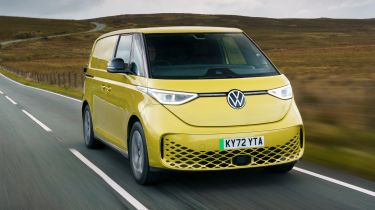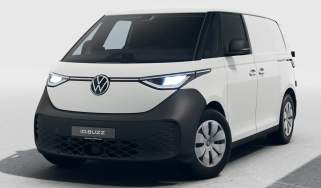Volkswagen ID. Buzz Cargo van review
The all-electric Volkswagen ID. Buzz Cargo van offers style and a useful long range for business buyers
Our opinion on the Volkswagen ID. Buzz Cargo
If you're a business looking for a van that creates a positive impression wherever it goes, then the Volkswagen ID. Buzz Cargo could be it. It has retro-inspired looks that mean it stands out from rival vans, while its all-electric running gear offers an excellent driving range for an electric van, along with very fast charging.
There are drawbacks when it comes to practicality, though - the Cargo has 3.9 cubic metres of cargo volume, which is quite a bit less than most medium panel vans, along with a relatively low payload. It can only tow 1,000kg as well.
About the Volkswagen ID. Buzz Cargo
Under the skin, the VW ID. Buzz Cargo uses a version of the platform found under cars such as the Volkswagen ID.3, Volkswagen ID.4 and Volkswagen ID.5, and it shares its body with the passenger-carrying ID. Buzz. That means it's quite car-like to drive, while the large 77kWh battery means the ID. Buzz Cargo has an official WLTP driving range of up to 276 miles.
There's just one body style at launch, a panel van. Although a longer model has been anticipated for several years, but hasn’t yet materialised. There are twin sliding side doors and either a tailgate or symmetrical twin doors at the rear, which open to reveal a 3.9 cubic-metre cargo area, although this is relatively small when compared with its rivals.
Used - available now

2026 BMW
4 Series
26,030 milesAutomaticPetrol2.0L
Cash £25,997
2025 Audi
A5 Sportback
37,025 milesAutomaticDiesel2.0L
Cash £25,197
2026 BMW
i4
25,438 milesAutomaticElectric
Cash £29,197
2023 Land Rover
Range Rover Evoque
28,804 milesAutomaticPetrol1.5L
Cash £25,697There's a plastic bulkhead separating the cargo area from the cab, where you'll find three-abreast seating. The ID. Buzz Cargo features a lot of black plastic trim, which distinguishes it from the passenger version that uses lighter-coloured plastics, although the digital displays are essentially the same.
Power comes from an electric motor that drives the rear wheels, with either 168bhp or 282bhp. There’s also an all-wheel drive version with two motors and an impressive 335bhp. Every version features a single-speed transmission, which is operated via a drive selector on the right-hand side steering column stalk.
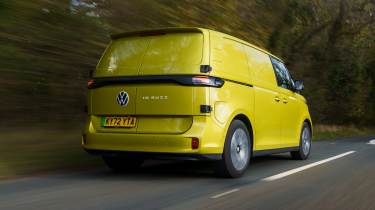
There's a long list of safety kit as standard, thanks to those car-derived underpinnings. It includes autonomous emergency braking, tyre pressure monitors, front and rear parking sensors, driver and passenger airbags and cruise control with intelligent speed assist.
Some might argue that the VW ID. Buzz Cargo is a unique proposition, thanks to its head-turning looks, but competitive pricing and strong residual values mean it should be on any electric van buyer's shortlist. Prices start from around £36,000 for the basic Commerce trim, and there’s a big jump up in price to the more lavishly equipped £43,000 Commerce Plus version, while adding 4Motion all-wheel drive takes it to £44,000.
The main rivals for the ID. Buzz Cargo include the Stellantis group electric van line-up, comprising the Citroen e-Dispatch, Fiat e-Scudo, Peugeot e-Expert, Toyota Proace Electric, and Vauxhall Vivaro Electric. Other options include the Mercedes eVito and Maxus e Deliver 3.
Range, charging & running costs

| Pros |
|
| Cons |
|
The Volkswagen ID. Buzz Cargo has a bespoke electric vehicle platform, which offers benefits in terms of efficiency compared with rival electric vans that are converted from diesel models. There's space under the floor for a large 77kWh battery, giving it a slight range advantage over the 75kWh battery offered in the Stellantis Group electric vans. A smaller 59kWh battery is also offered in the entry-level ID.Buzz Cargo to keep the price down.
As with other electric models, the ID. Buzz Cargo has different driving modes that help to recoup energy for the battery when slowing down. There are just two settings, with the 'D' mode offering regular coasting when lifting off the throttle, while the 'B' mode offers stronger resistance. It's not enough to deliver one-pedal driving at low speeds, but it offers decent energy recovery and the equivalent of engine braking when coasting downhill, so you don't need to press the brakes in these circumstances. VW claims that the drive system handles braking at deceleration rates of up to 0.3g, while switching from this mode to the mechanical brakes is smooth.
Electric range, battery life and charge time
VW quotes a range of up to 276 miles on the combined WLTP test, which is around 50 miles ahead of the Stellantis vans. That's quite a margin for a battery that's only just a bit bigger, and means that the ID. Buzz Cargo’s driving range is only beaten by the Renault Master E-Tech, which is a far bigger van. Even more impressive is that the WLTP City figure (which focuses on low-speed urban driving) is 384 miles - a handy figure for multi-drop delivery drivers with short hops between each address.
VW offers the entry-level ID. Buzz Cargo with a 59kWh battery to bring down its starting price. This gets a range of 200 miles combined or closer to 272 miles in the city, and is perfect for those who don’t go all that far during each shift
The ID. Buzz Cargo is capable of being rapidly charged, allowing you to quickly top up en route. Power sources of up to 185kW can be used, and at this charging rate, the battery can be topped up from five to 80 per cent capacity in around half an hour. If you're using an AC wallbox, a full charge takes 7.5 hours using an 11kW source, or 11 hours from a 7kW supply.
Using VW's combustion-engined commercial vehicles as a reference, you might expect the ID. Buzz Cargo to command a premium over rival vans. However, that's not the case. It undercuts the 75kWh versions of the Stellantis group vans, while strong residual values mean it won't lose as much in depreciation as these vans, either.
Load space and practicality
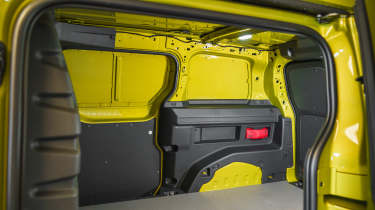
| Pros |
|
| Cons |
|
While the VW ID. Buzz Cargo undercuts its rivals on price, the penalty is that it's not the roomiest van for its size. Measuring 4,712mm long and 1,985mm wide, it's slightly shorter than most medium-sized vans, and while VW claims that the ID. Buzz Cargo has enough floor space to fit two Euro pallets inside, the high floor limits the van's capacity.
There's a maximum volume of 3.9 cubic metres on offer, which is a capacity equalled by maxi versions of vans in the small class. For reference, a Ford Transit Custom has around six cubic metres of space. If you're going electric, models such as the Citroen e-Berlingo and Renault Kangoo e-Tech offer just as much space for a lot less money.
Access is reasonable, rather than outstanding. You get two sliding side doors (not always standard fit on vans of this size), but the openings measure 756mm wide, which is narrower than most rivals. At the back, buyers can specify a top-hinged tailgate or twin doors with a 50:50 split. Going for the latter frees up some extra floor space if that's critical to you.
The floor length of the tailgate-equipped van is 2,208 mm, while the twin-door version measures 2,232mm. At the other end of the cargo area is a hard plastic bulkhead, but there's no through-loading facility to help when carrying around long pipes or planks of wood. The floor has a maximum width of 1,217mm, and there is minimal wheel arch intrusion, largely due to the floor being quite high to accommodate the 77kWh battery and rear-mounted electric motor.
The floor is tall enough that there are two steps into the cargo area, while there's also room on the offside behind a panel to stow the charging cables and keep them tidied away from the load area. There's a maximum height of 1,330mm inside, while the load lip at the rear is 632mm off the ground. Convenience features in the cargo area include six lashing eyes in the floor with two more on either side of the rear wheel arches, LED interior lighting and a 12-volt charging socket.
Reliability, safety and security

| Pros |
|
| Cons |
|
Since it's based on the Volkswagen Group's primary electric vehicle platform, the ID. Buzz Cargo's running gear should prove to be reliable, because it has had many millions of miles of development put on it. The ID. Buzz is a later arrival than models such as the ID.3 and ID.4, so any issues with their production should have helped with ID. Buzz assembly.
Those car-derived roots incorporate a suite of the latest safety tech, too. There are twin front airbags for starters – not all vans come with a passenger airbag as standard – while side and curtain airbags are also included. All three seats have full three-point seatbelts, while a belt reminder is also included.
There's autonomous emergency braking with cyclist and pedestrian detection, a driver tiredness monitor, tyre pressure monitors and VW's Car2X system, which allows the ID. Buzz Cargo will network with other compatible vehicles to offer real-time traffic information via a subscription service.
Dynamic road sign display and lane keeping are included, as is an emergency eCall system, and front and rear parking sensors. For those with awkward access to a parking space, you can program up to five automated parking manoeuvres with the optional park assist system to let the vehicle automatically reverse into your space.
Driving and performance
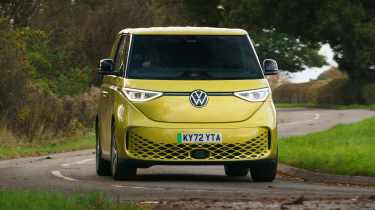
| Pros |
|
| Cons |
|
From its launch, power for the ID. Buzz Cargo came solely from a 201bhp electric motor mounted at the back of the van and driving the rear wheels. We’ve tested this version, and thanks to its 310Nm of torque - which is available from the moment you press the accelerator - the ID. Buzz Cargo feels rapid when pulling away from a standstill, certainly a lot more potent than its Stellantis group rivals, as its 10.2-second 0-62mph time will concur.
Volkswagen has now tweaked the line-up, so if you don't need something that quick, you can go for the entry-level 59kWh battery model with a still respectable 168bhp rear motor. Replacing the original 201bhp electric motor is an upgraded 282bhp version with a 79kWh battery. The extra power slashes the van’s 0-62mph acceleration to just 7.9 seconds. We’re yet to try the 4Motion all-wheel drive range-topper, but its dual electric motors provide an impressive 335bhp and 550Nm, so it’s likely to be capable of some very speedy deliveries.��
With so much power on tap, the ID. Buzz Cargo should make light work of any payload on board. VW quotes a towing weight of one tonne for the van, although rivals can haul even more.
Town driving, visibility and parking
Measuring just 4.7m in length and with rear-axle steering contributing to a turning circle of just over 12 metres, the ID. Buzz feels very wieldy and manoeuvrable around town. A high driving position and large windows mean visibility is very good. The suspension is a little on the firm side in order to cope with heavier loads in the back. This means you'll feel the bumps at low speeds when the cargo area is empty, but things will improve with some weight in the back.
Motorway driving and long-distance comfort
The ID. Buzz Cargo is very smooth for a van, which is another side effect of its car-derived platform. The suspension, while quite firm for a van, does a good job of smothering bumps in the road at speed very well, making it a very relaxing place to spend time and giving it far better control over body movements in the bends than your typical van. Wind noise and road noise are impressively well suppressed, although impacts with bigger bumps can cause shudders to echo through the van's frame, especially when unloaded.
Cab interior and technology
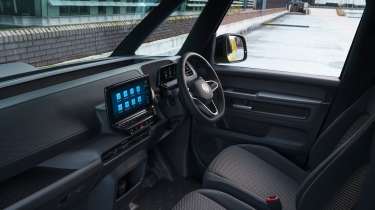
| Pros |
|
| Cons |
|
The high-quality interior of the ID. Buzz Cargo really sets it apart from rival vans. True, the Cargo model isn’t as elegant as the regular Buzz, because instead of the bright colours and 'Play' and 'Pause' pedals of the normal Buzz, you get a black plastic dashboard, far more sombre upholstery across the seats, and conventional rubber pedals. But overall, no other commercial vehicle this side of a Land Rover Defender Hard Top is as plush.
The dashboard layout is largely the same, though, with a small digital instrument pod that moves with the steering wheel when adjusted, while a large 12.9-inch colour touchscreen houses all the essential functions.
The three-seat layout is wide enough for three adults, and the fabric trim looks like it will withstand van life. The driver's seat is heated, which helps to save battery energy on colder days, and storage is decent, too. There are double door bins and a long storage tray on top of the dashboard, a second shelf above the glovebox, cup holders at either end of the dashboard and a useful shelf below the central air vents with USB-C sockets and enough space for a smartphone.
Infotainment, sat-nav and stereo
The ID. Buzz Cargo is well-specced for a van thanks to its close relationship with the MPV variant. The Commerce trim includes climate control, heated electric door mirrors, parking sensors front and rear, a multifunction steering wheel (although it's fitted with VW's frustrating touch-sensitive controls), wireless Apple CarPlay and Android Auto with online connectivity on offer, plus a first aid kit.
Upgrade to Commerce Plus and you’ll also get navigation with connected services, a heated windscreen, keyless entry, adaptive cruise control, a rear-view camera, body-coloured exterior trim, extra LED lights dotted around the exterior and 19-inch bi-colour alloy wheels.
Buying and owning
There are several ways to approach buying the ID. Buzz Cargo. In many respects, the entry-level Commerce trim with the smaller 59kWh battery makes sense because it represents the best value, and most drivers won’t cover more than 200 miles per day.
However, part of the reason to buy the Volkswagen is its alluring style and the image it projects; as a result, many business owners won’t be able to resist the highly specced and handsome Commerce Plus trim. The latest 4Motion version with 335bhp gets a serious dose of performance, but the regular two-wheel drive 79kWh version with 282bhp is better value because it’s already much quicker than a regular van, and you wouldn’t want to risk breaking your valuable cargo racing away from the traffic lights.
Volkswagen ID. Buzz Cargo alternatives
Electric vans like the Ford e-Transit Custom and Vauxhall Vivaro Electric (along with its Citroen, Peugeot, Toyota and Fiat sister models) offer quite a bit more practicality than the ID. Buzz Cargo, but lack its flair, premium feel and ultra-fast charging capabilities.
At 4.4 cubic metres, even the smaller and cheaper Citroen e-Berlingo gets more cargo volume than the Volkswagen. However, it can’t charge as fast or go as far on a single charge, and it feels much cheaper from behind the wheel.
The LEVC VN5 is a quirky alternative with more character than most vans thanks to the nose it shares with the TX London black cab. It also uses a range-extender plug-in hybrid powertrain rather than being fully electric, so you can simply carry on using petrol power rather than having to stop and recharge.
| Van dimensions | |||
| Body style | Height | Width | Length |
| L1 van | 1,899mm | 1,985mm | 4,712mm |
| Load area dimensions | ||||
| Body style | Height | Width | Length | Volume |
| L1 van | 1,330mm | 1,217mm | 2,208mm | 3.9m3 |
Frequently Asked Questions
That very much depends on what you need from your van. If you want the most stylish load-lugger on the market, a great electric range, fast charging and excellent performance, it scores highly. If you simply need to carry and tow the most cargo, with minimal costs, look elsewhere.
